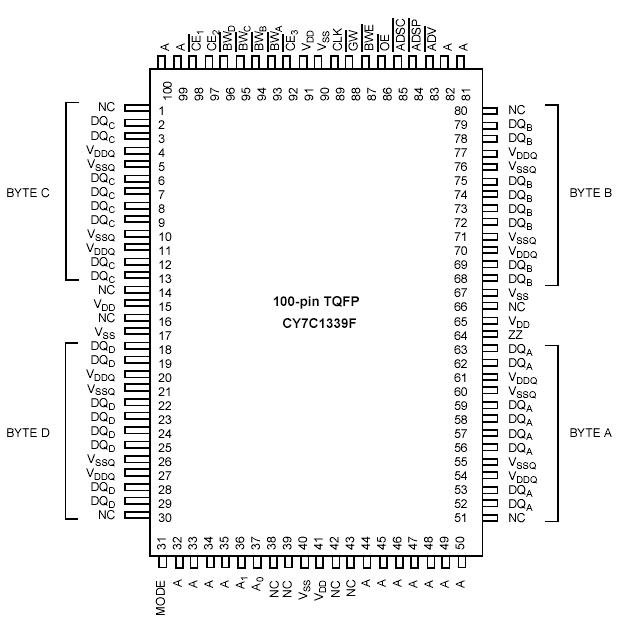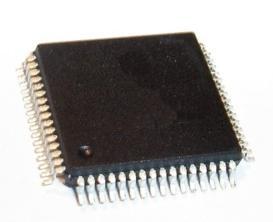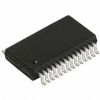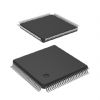Features: • Registered inputs and outputs for pipelined operation
• 128K * 32 common I/O architecture
• 3.3V core power supply
• 2.5V / 3.3V I/O operation
• Fast clock-to-output times
- 2.6 ns (for 250-MHz device)
- 2.6 ns (for 225-MHz device)
- 2.8 ns (for 200-MHz device)
- 3.5 ns (for 166-MHz device)
- 4.0 ns (for 133-MHz device)
- 4.5 ns (for 100-MHz device)
• Provide high-performance 3-1-1-1 access rate
• User-selectable burst counter supporting Intel Pentium interleaved or linear burst sequences
• Separate processor and controller address strobes
• Synchronous self-timed writes
• Asynchronous output enable
• Offered in JEDEC-standard 100-pin TQFP and 119-ball BGA packages
• "ZZ" Sleep Mode OptionPinout SpecificationsStorage Temperature ..............................65°C to +150°C
SpecificationsStorage Temperature ..............................65°C to +150°C
Ambient Temperature with
Power Applied..........................................55°C to +125°C
Supply Voltage on VDD Relative to GND........ 0.5V to +4.6V
DC Voltage Applied to Outputs
in three-state .................................... 0.5V to VDDQ + 0.5V
DC Input Voltage...................................0.5V to VDD + 0.5V
Current into Outputs (LOW)........................................ 20 mA
Static Discharge Voltage........................................... >2001V
(per MIL-STD-883, Method 3015)
Latch-up Current..................................................... >200 mADescriptionThe CY7C1339F SRAM integrates 131,072 x 32 SRAM cells with advanced synchronous peripheral circuitry and a two-bit counter for internal burst operation. All synchronous inputs are gated by registers controlled by a positive-edge-triggered Clock Input (CLK). The synchronous inputs of CY7C1339F include all addresses, all data inputs, address-pipelining Chip Enable (CE1), depth-expansion Chip Enables (CE2 and CE3), Burst Control inputs (ADSC, ADSP, and ADV), Write Enables (BW[A:D], and BWE), and Global Write (GW). Asynchronous inputs include the Output Enable (OE) and the ZZ pin.
Addresses and chip CY7C1339F enables are registered at rising edge of clock when either Address Strobe Processor (ADSP) or Address Strobe Controller (ADSC) are active. Subsequent burst addresses can be internally generated as controlled by the Advance pin (ADV). Address, data inputs, and write controls are registered on-chip to initiate a self-timed Write cycle.This part supports Byte Write operations (see Pin Descriptions and Truth Table for further details). Write cycles CY7C1339F can be one to four bytes wide as controlled by the byte write control inputs. GW when active LOW causes all bytes to be written.
The CY7C1339F operates from a +3.3V core power supply while all outputs may operate with either a +2.5 or +3.3V supply. All inputs and outputs are JEDEC-standard JESD8-5-compatible.

 CY7C1339F Data Sheet
CY7C1339F Data Sheet








